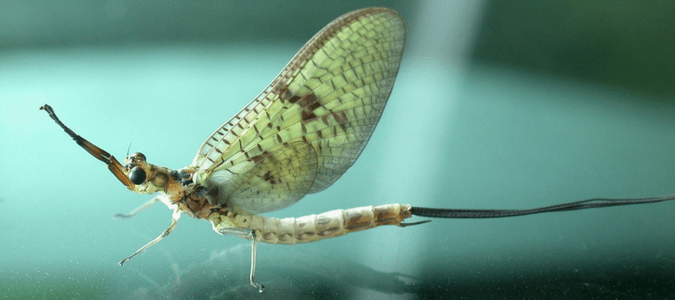
If you’ve ever seen a gathering of flies around your home’s doorways or entryway, you’ve probably encountered a gathering of mayflies. But whether you correctly identified them, well, that’s another story. That’s because mayflies are often misidentified as dragonflies and damselflies. Although these creatures are relatively harmless, chances are you don’t want mayflies inside your home.
How To Get Rid of Mayflies
Warmer months often mean more flies and insects flying around and outside your home. When you start noticing flying insects, the next step is usually taking steps to keep these insects from getting inside your home. Let’s discuss how to correctly identify mayflies, what to do if you have an infestation, and ways to prevent them from infesting your home again.
Identification
Despite their name, the mayfly is unrelated to a housefly or other true flies. And though they might look the same at first glance, the two species are quite different. Unlike house flies, mayflies have two pairs of wings, not one. Furthermore, their wings are transparent and held together over their bodies when still.
While most mayflies have similar body types, there are more than 3,000 species of flying insects. As a result, there are some differences you might notice. For example, while some mayflies have a small, slender body—some measure just one millimeter in length—others can grow up to 30 millimeters long (or about an inch). Regardless of length, all mayflies have two or three long tails extending from their body’s end. Many species have dark bodies, and most have a greenish tint.
Habitat and Lifecycle
The mayfly belongs to the Ephemeroptera order. They are aquatic insects, so they spend the majority of their lives in or around water. After mating, females lay their eggs on the surface of a body of water; they can lay thousands of eggs at a time. However, it’s important to note that mayflies prefer to seek out clean, fresh bodies of water to lay their eggs.
After the female lays eggs, the eggs sink beneath the water and stick to plants and stones. At this point, the eggs are referred to as nymphs. Depending on water conditions and the mayfly species, the nymph can hatch after a few days or a number of weeks.
Even after hatching, the nymphs live underwater, finding shelter under stones. Nymphs feed on aquatic plants and organisms during this time by scraping algae from stones and vegetation. A common question is: Do mayflies bite? Unlike other insects, the larval and nymph stages are the only time the mayfly eats, as adult mayflies don’t have a functioning mouths. Again, depending on the water conditions and species, the nymph stage can last just a few months or up to a few years and involve several sheddings of its hard outer layer of skin.
Once the nymph is fully developed, it finds its way to the water’s surface and emerges from its covering; it becomes an adult once its wings are fully dry. As an adult, though, the mayfly can live as little as two minutes and up to two days. The Mayfly has one of the shortest lifespans of all insects and lasts only long enough to reproduce. That means if a mayfly finds its way inside, it won’t be there for very long.
A Mayfly Swarm
You may have seen videos or heard news stories about a mayfly swarm. These invasions occur in certain parts of the country when millions of insects leave large bodies of water at one time during mating season. In a scene out of a horror movie, mayflies have covered roadways and blanketed cars in Illinois, Michigan, and Iowa. In some instances, the insects have piled up, knee-deep, and swarms have been big enough to resemble storms on local weather radar systems. Since these insects don’t bite, mayfly swarms only pose an inconvenience. After the insect mate, piles of bodies are left to be swept away.
Prevention
Thankfully, mayfly swarms are few and far between and occur outdoors. Most of us would prefer to keep these insects in their ideal habitat: outside. The best way to spot a group of mayflies is by looking at your home’s lighting and entryways. That’s because adult mayflies are attracted to light and often gather in large numbers around homes and buildings.
If you want to get rid of mayflies, you’ll first want to remove any white lights. Start by changing white lights with yellow or bug lights and closing curtains or shutters at night to keep indoor lights from attracting new bugs. Another way to prevent mayflies is by removing access to clean bodies of water. Because an adult’s primary purpose is to reproduce, removing possible breeding grounds will eliminate your home’s appeal. If you have a pool or other standing bodies of water that can’t be obliterated, be sure they’re free of algae or any possible food sources, like fallen leaves.
A Trusted Resource for Pest Control
If you encounter a pest problem you can’t handle on your own, the best thing to do is call in the professionals. Our pest control experts and technicians at ABC Home & Commercial Services are trusted resources for any and all pest control concerns. Our team will correctly identify the source of the problem and work with you to find the best way to ensure your home is safe and pest-free for years to come.